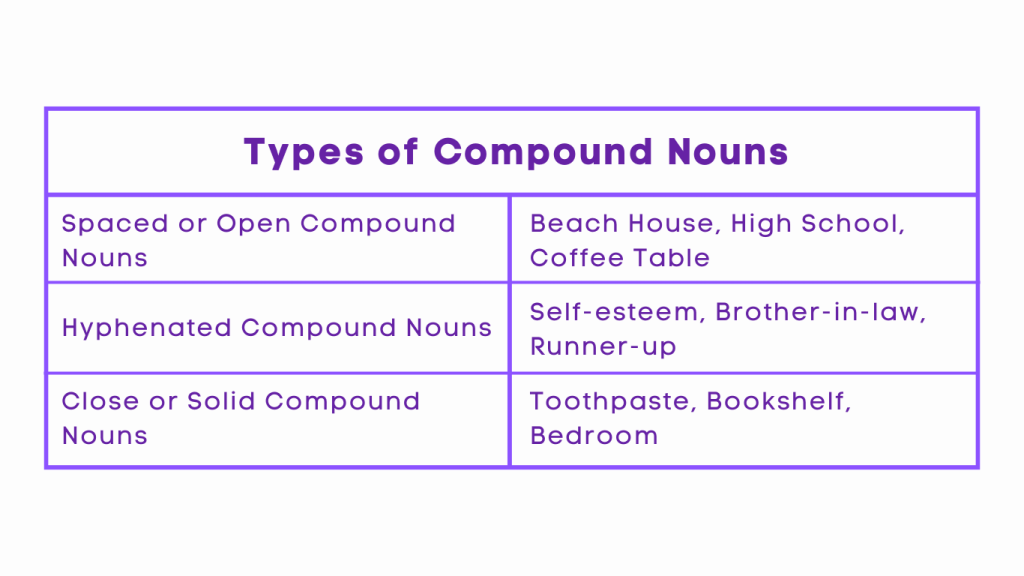Compound Nouns – Meaning and Examples
Table of Contents
Introduction
What is a Compound Noun?
In the English language, compound nouns play a crucial role in forming meaningful and descriptive expressions. A compound noun is a combination of two or more words that together represent a single concept or entity. It is one of the types of nouns. These words can be joined together in various ways, leading to different types of compound nouns.
Analogy of Definition
Types of Compound Nouns
There are three main types of compound nouns: spaced or open compound nouns, hyphenated compound nouns, and closed or solid compound nouns. Each type has its own rules for formation and usage, contributing to the richness and diversity of the English language.
Spaced or Open Compound Nouns
When forming a spaced or open compound noun, two separate words are joined together with a space. This type of compound noun maintains distinct words within the phrase.
Hyphenated Compound Nouns
In a hyphenated compound noun, the two words are linked with a hyphen. This punctuation mark helps to connect the words while still indicating their individuality within the compound noun.
Closed or Solid Compound Nouns
Closed or solid compound nouns are formed without any spaces or hyphens between the constituent words. Instead, the words are fused together, creating a single entity.

Method
Forming Compound Nouns
Compound nouns can be formed through different combinations of words, including noun + noun, noun + verb, noun + gerund, noun + preposition, preposition + verb, verb + preposition, , adjective + noun, and adjective + verb. Additionally, compound nouns can be created using repetitive/rhyming words, places, nationalities, and titles.

Examples
Examples of Compound Nouns
1. Spaced or Open Compound Noun: “Full moon”
2. Hyphenated Compound Noun: “Sister-in-law”
3. Closed or Solid Compound Noun: “Bedroom”
Quiz
Tips and Tricks
1. Forming Compound Nouns with Noun + Noun
Tip: Combine two nouns to create a compound noun that represents a single entity or concept. Example: “Rainbow” (rain + bow)
2. Creating Compound Nouns with Adjective + Noun
Tip: Use an adjective and a noun to form a compound noun that describes a specific quality or characteristic. Example: “Blackboard” (black + board)
3. Using Repetitive/Rhyming Words in Compound Nouns
Tip: Combine words that repeat or rhyme to form a compound noun that emphasizes a particular sound or pattern. Example: “Ping-pong” (ping + pong)
4. Forming Compound Nouns with Noun + Preposition + Noun
Tip: Connect a noun, preposition, and another noun to create a compound noun that signifies a relationship or connection between the two nouns. Example: “Daughter-in-law” (daughter + in + law)
5. Creating Compound Nouns with Places, Nationalities, and Titles
Tip: Use names of places, nationalities, or titles to form compound nouns that represent specific geographical locations, cultural identities, or official positions. Example: “Frenchman” (French + man)
Real life application
Story: “The Adventures of Compound Nouns”
In a world where words come to life, compound nouns play a vital role in shaping the language and communication of its inhabitants. Let’s explore how compound nouns are used in various real-life scenarios.
Scenario 1: The School Environment
In a bustling school environment, compound nouns are everywhere. From “classroom” to “homework” and “textbook,” these compound nouns describe the different aspects of the educational experience, highlighting the interconnectedness of learning and knowledge.
Scenario 2: The Medical Field
In the medical field, compound nouns are essential for describing various conditions, treatments, and medical equipment. Terms such as “blood pressure,” “heart attack,” and “X-ray” are examples of compound nouns that help medical professionals communicate effectively and accurately.
Scenario 3: The Business World
In the business world, compound nouns are used to describe organizational structures, financial concepts, and marketing strategies. Phrases like “boardroom,” “cash flow,” and “brand name” exemplify the diverse applications of compound nouns in the corporate environment.
FAQ's
Like? Share it with your friends






